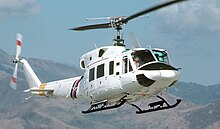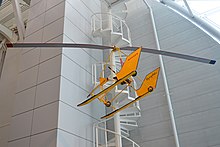


Arotorcraftorrotary-wing aircraft is a heavier-than-air aircraft with rotary wings or rotor blades, which generate lift by rotating around a vertical mast. Several rotor blades mounted on a single mast are referred to as a rotor. The International Civil Aviation Organization (ICAO) defines a rotorcraft as "supported in flight by the reactions of the air on one or more rotors".[1]
Rotorcraft generally include aircraft where one or more rotors provide lift throughout the entire flight, such as helicopters, autogyros, and gyrodynes. Compound rotorcraft augment the rotor with additional thrust engines, propellers, or static lifting surfaces. Some types, such as helicopters, are capable of vertical takeoff and landing. An aircraft which uses rotor lift for vertical flight but changes to solely fixed-wing lift in horizontal flight is not a rotorcraft but a convertiplane.

A helicopter is a powered rotorcraft with rotors driven by the engine(s) throughout the flight, allowing it to take off and land vertically, hover, and fly forward, backward, or laterally. Helicopters have several different configurations of one or more main rotors.
Helicopters with a single shaft-driven main lift rotor require some sort of antitorque device such as a tail rotor, fantail, or NOTAR, except some rare examples of helicopters using tip jet propulsion, which generates almost no torque.

An autogyro (sometimes called gyrocopter, gyroplane, or rotaplane) uses an unpowered rotor, driven by aerodynamic forces in a state of autorotation to develop lift, and an engine-powered propeller, similar to that of a fixed-wing aircraft, to provide thrust. While similar to a helicopter rotor in appearance, the autogyro's rotor must have air flowing up and through the rotor disk in order to generate rotation. Early autogyros resembled the fixed-wing aircraft of the day, with wings and a front-mounted engine and propeller in a tractor configuration to pull the aircraft through the air. Late-model autogyros feature a rear-mounted engine and propeller in a pusher configuration.
The autogyro was invented in 1920 by Juan de la Cierva. The autogyro with pusher propeller was first tested by Etienne Dormoy with his Buhl A-1 Autogyro.

The rotor of a gyrodyne is normally driven by its engine for takeoff and landing – hovering like a helicopter – with anti-torque and propulsion for forward flight provided by one or more propellers mounted on short or stub wings. As power is increased to the propeller, less power is required by the rotor to provide forward thrust resulting in reduced pitch angles and rotor blade flapping. At cruise speeds with most or all of the thrust being provided by the propellers, the rotor receives power only sufficient to overcome the profile drag and maintain lift. The effect is a rotorcraft operating in a more efficient manner than the freewheeling rotor of an autogyro in autorotation, minimizing the adverse effects of retreating blade stall of helicopters at higher airspeeds.

A rotor kite or gyroglider is an unpowered rotary-wing aircraft. Like an autogyro or helicopter, it relies on lift created by one or more sets of rotors in order to fly. Unlike a helicopter, autogyros and rotor kites do not have an engine powering their rotors, but while an autogyro has an engine providing forward thrust that keeps the rotor turning, a rotor kite has no engine at all, and relies on either being carried aloft and dropped from another aircraft, or by being towed into the air behind a car or boat.
A rotary wing is characterised by the number of blades. Typically this is between two and six per driveshaft.
A rotorcraft may have one or more rotors. Various rotor configurations have been used:
Some rotary wing aircraft are designed to stop the rotor for forward flight so that it then acts as a fixed wing. For vertical flight and hovering it spins to act as a rotary wing or rotor, and for forward flight at speed it stops to act as a fixed wing providing some or all of the lift required. Additional fixed wings may also be provided to help with stability and control and to provide auxiliary lift.
An early American proposal was the conversion of the Lockheed F-104 Starfighter with a triangular rotor wing. The idea was later revisited by Hughes.[3] The Sikorsky S-72 research aircraft underwent extensive flight testing.
In 1986 the Sikorsky S-72 Rotor Systems Research Aircraft (RSRA) was fitted with a four-bladed stopped rotor, known as the X-wing. The programme was cancelled two years later, before the rotor had flown.
The later canard rotor/wing (CRW) concept added a "canard" foreplane as well as a conventional tailplane, offloading the rotor wing and providing control during forward flight. For vertical and low-speed flight, the main airfoil is tip-driven as a helicopter's rotor by exhaust from a jet engine, and there is no need for a tail rotor. In high-speed flight the airfoil is stopped in a spanwise position, as the main wing of a three-surface aircraft, and the engine exhausts through an ordinary jet nozzle. Two Boeing X-50 Dragonfly prototypes with a two-bladed rotor were flown from 2003 but the program ended after both had crashed, having failed to transition successfully.[4]
In 2013 the US Naval Research Laboratory (NRL) published a vertical-to-horizontal flight transition method and associated technology, patented December 6, 2011,[5] which they call the Stop-Rotor Rotary Wing Aircraft.[6] The Australian company StopRotor Technology Pty Ltd has developed a prototype Hybrid RotorWing (HRW) craft.[7][8] The design uses high alpha airflow to provide a symmetrical airflow across all the rotor blades, requiring it to drop almost vertically during transition.[8] Inflight transition from fixed to rotary mode was demonstrated in August 2013.[9][10][11]
Another approach proposes a tailsitter configuration in which the lifting surfaces act as a rotors during takeoff, the craft tilts over for horizontal flight and the rotor stops to act as a fixed wing.[12]
| External videos | |
|---|---|
|
Helicopters and other rotorcraft
| ||||||
|---|---|---|---|---|---|---|
| Helicopters |
| |||||
| Other rotorcraft |
| |||||
| Hazards |
| |||||
| Related |
| |||||
| ||||||
|
| |||||||||||||||||||||||||
|---|---|---|---|---|---|---|---|---|---|---|---|---|---|---|---|---|---|---|---|---|---|---|---|---|---|
| |||||||||||||||||||||||||
| |||||||||||||||||||||||||
| Authority control databases: National |
|
|---|